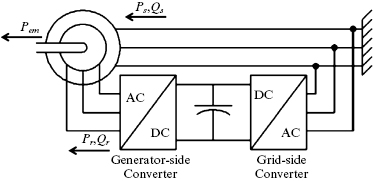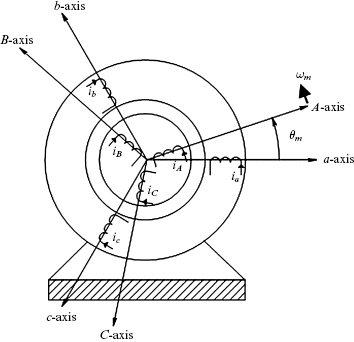7Dynamic Analysis of Doubly Fed Induction Generators and Their Vector Control
Doubly fed induction generators (DFIGs) are used in harnessing wind energy. The principle of operation of doubly wound induction machines was described in steady state in Reference [1]. In this chapter, we will mathematically describe doubly wound induction machines in order to apply vector control. As an introduction, Fig. 7-1 shows a doubly fed induction generator.

The cross-section of a DFIG is shown in Fig. 7-2. It consists of a stator, similar to the squirrel-cage induction machines, with a three-phase winding, each having Ns turns per phase that are assumed to be distributed sinusoidally in space. The rotor consists of a wye-connected three-phase windings, each having Nr turns per phase that are assumed to be distributed sinusoidally in space. Its terminals, A, B, and C, are supplied appropriate currents through slip-rings and brushes, as shown in Fig. 7-1b.

The benefits of using a DFIG in wind applications are as follows:
- The speed can be control over a sufficiently wide range to make the turbine operate at its optimum coefficient of performance Cp.
Get Advanced Electric Drives: Analysis, Control, and Modeling Using MATLAB/Simulink now with the O’Reilly learning platform.
O’Reilly members experience books, live events, courses curated by job role, and more from O’Reilly and nearly 200 top publishers.

